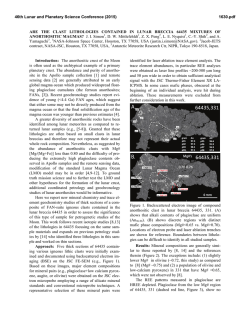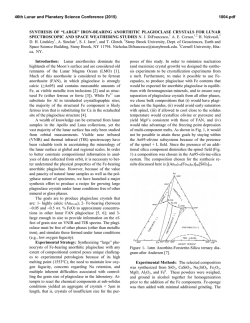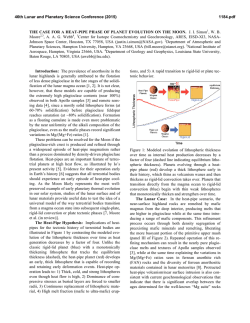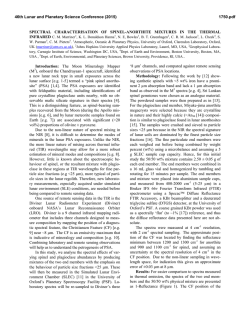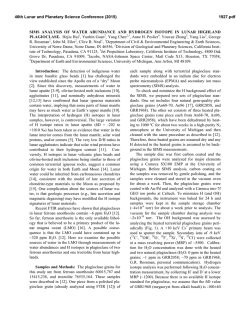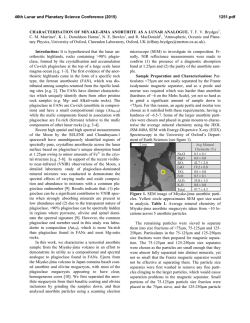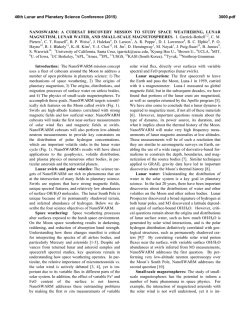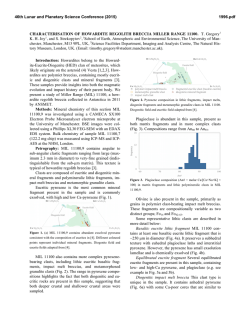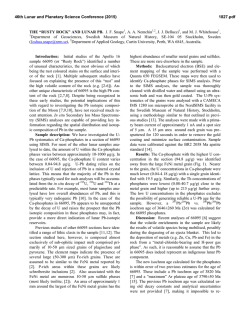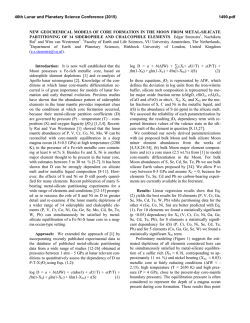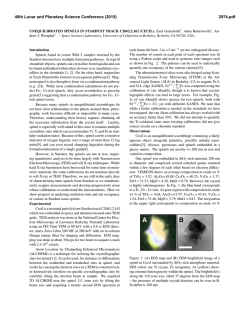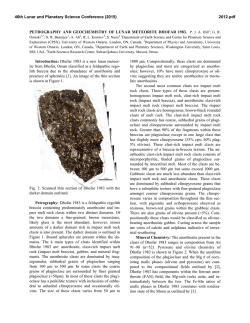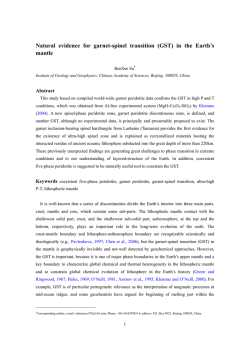
Cordierite from the Dhofar 025 Lunar Feldspathic Meteorite
46th Lunar and Planetary Science Conference (2015) 1772.pdf CORDIERITE FROM THE DHOFAR 025 LUNAR FELDSPATHIC METEORITE. S. I. Demidova1, M. A. Nazarov1, K. M. Ryazantsev1, F. Brandstätter2 and Th. Ntaflos3, 1Vernadsky Institute of Geochemistry and Analytical Chemistry, Kosygin St. 19, Moscow 119991, Russia, [email protected]; 2Naturhistorisches Museum, Burgring 7, 1010 Vienna, Austria; 3Department für Lithosphärenforschung, Universität Wien, Althanstrasse 14, 1090 Wien, Austria. Introduction: Cordierite is an extremely rare phase in lunar rocks. The mineral was documented as a minor phase in the Apollo 15 spinel troctolite 15295,101 [1] and as a single inclusion in spinel from the Apollo 17 spinel cataclasite 72435 [2]. In lunar meteorites cordierite has never been found before. Here we report on an occurrence of cordierite in the Dhofar 025 lunar feldspathic meteorite. Methods: A polished thick section of Dho 025 was studied using traditional methods of optical and electron microscopy (JEOL JSM-6610LV with a Gatan MonoCL4 CL system). Chemical compositions of the mineral phases were measured using a JEOL JXA8530F and Cameca SX100 microprobes in Vienna. Results: Dho 025 is an anorthositic impact melt breccia containing mineral and lithic fragments set within a glassy impact melt matrix [3]. Lithic clasts of anorthositic, noritic, gabbro-noritic and troctolitic composition are common. Two clasts of VLT basalts were found as well. Most of the lithic clasts are impact melt breccias and crystalline impact melts. However granulitic and cataclastic rocks are present as well. Coarse-grained lithic clasts with a possibly primary texture are rare. Recrystallization is typical for many lithic fragments of the Dho 025 meteorite. Pyroxene is mainly orthopyroxene En53-94Wo1-5, pigeonite and augite En39-74Wo5-45. Olivine is Fo61-95. Plagioclase is An93-98. Accessory minerals are Al-Ti chromite, spinel, ilmenite, troilite, Fe-Ni metal. It should be noted that Dho 025 is moderately weathered and has one of the oldest terrestrial ages among lunar meteorites [4]. One grain of plagioclase (150x280 µm in size) set within the impact-melt matrix of the meteorite contains an inclusion of polygonal shape (43x50 µm in size) (Fig. 1,2a). The inclusion has mostly a sharp boundary with the host plagioclase. One side of the inclusion contacts with the impact-melt matrix of the meteorite. The inclusion consists of symplectite intergrowths cordierite and an Al-rich phase (<1 of µm in size) that is too small for a precise analysis but appears to be pleonaste. The cordierite composition is presented in Table 1 and corresponds to the formula Mg1.78Fe0.26Al4.02Si4.93O18 Mineral modes of the inclusion are 87 wt.% cordierite and 13 wt.% pleonaste. Host plagioclase is An97 containing 0.2-0.3 wt.% FeO and 0.1 wt.% MgO. A CL study shows that the core of this plagioclase is shocked whereas the rim does not have any shock features (Fig. 2), suggesting the post-shock formation. Table 1. Chemical composition of lunar cordierites and the calculated bulk composition of the Dho 025 inclusion. Crd Crd 15295,101 72435 [2] [1] Crd Bulk of Dho 025 Inclusion* (av. of 4 an.) SiO2 50.9 50.7 49.1 42.8 Al2O3 34.3 34.7 34.0 38.1 TiO2 0.06 0.12 0.09 0.08 K 2O 0.49 0.06 0.07 0.06 Na2O 0.03 0.08 0.08 0.07 CaO 0.05 0.06 0.22 0.19 FeO 0.84 3.94 3.11 5.25 MnO 0.02 0.05 0.04 0.03 MgO 13.3 12.1 11.9 12.3 MG# 97 85 87 81 sum 100.0 101.9 98.7 98.9 *The bulk composition was calculated on the basis of mineral modes and suggesting that pleonaste is in equilibrium with cordierite [5]. Fig.1. BSE image of the cordierite-pleonaste inclusion (cordierite - dark-grey; pleonaste – bright). 46th Lunar and Planetary Science Conference (2015) Discussion: In MG# cordierite of Dho 025 is lower than that of 15295,101 and similar to that of 72435 but has a little higher Ca content than two other lunar cordierites (Table 1). Соrdierite is a low pressure phase and can be formed in spinel troctolites with a lowered Ca content [6]. At a higher pressure cordierite reacts with olivine to produce high Al orthopyroxene and spinel according to the reaction: 5Mg2SiO4(Fo) + Mg2Al4Si5O18(Crd) = 10MgSiO3(En) + 2MgAl2O4(Spl) [5]. The reaction has been used to estimate PT conditions of formation of the spinel+Al-rich orthopyroxene association [5,6]. Thus, it can be suggested that the Dho 025 cordierite-bearing plagioclase grain could be a fragment of a spinel troctolite. However, the PT conditions of formation of the source rock of the plagioclase fragment cannot be calculated because the chemistry of co-existing mafic phases is unknown. Another possibility for the origin of the Dho 025 cordierite can be suggested by taking into account the cordierite-spinel symplectite. Such symplectites are unknown in lunar rocks but are common in high-grade terrestrial rocks and their formation is usually ascribed to cooling and/or decompression following a metamorphic peak. They are also known from metamorphic rocks in contact with igneous rocks which are believed to be the result of reaction with a melt [e.g. 7]. Compositions of the terrestrial symplectites have not been reported but the bulk composition of the Dho 025 cordierite-spinel symplectite (Table 1) corresponds to the formula Ca0.01Na0.01Mg0.83Fe0.20Al2.04Si1.94O8 that is very close to the Mg-analog of anorthite (MgAl2Si2O8). This phase is unknown in the nature but was synthesized by a solid state reaction at 1300ºC [8]. The field of stability of the phase has not yet been determined but we can suggest that the phase possibly exsolved from the host anorthite and then decomposed into cordierite and spinel. However, the morphology of the inclusion does not look like the result of an exsolution. Acknowledgements: This study was supported by Russian Academy of Sciences (Program #22). References: [1] Marvin U. B. et al. (1989) Science, 243, 925-928. [2] Dymek R. F. et al. (1976) Proc. Lunar Sci. Conf. VII, 2335-2378. [3] Cahill J. T. et al. (2004) Meteoritics & Planet. Sci., 39, 503-529. [4] Nishiizumi K. and Caffee M.W. (2001) Meteoritics & Planet. Sci., 36, A148. [5] Herzberg C. T. and Baker M. B. (1980) Proc. Conf. Lunar Highland Crust., 113-132. [6] Nazarov M. A. et al. (2011) Petrology, 19, 13-25. [7] Pitra P. and De Waal S. A. (2001) J. Metamorphic Geol., 19, 311-325. [8] Ozturk E. et al. (2014) JCCS, 61, DOI:10.1002/jccs.201400294. 1772.pdf (a) (b) Fig. 2. SE (a) and CL(b) images of the plagioclase grain containing the cordierite-pleonaste inclusion.
© Copyright 2025
